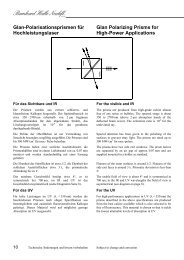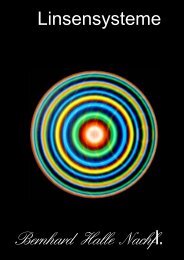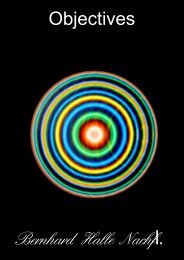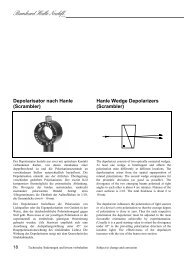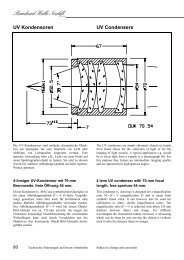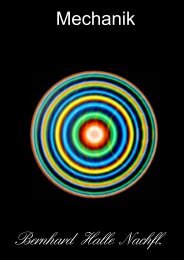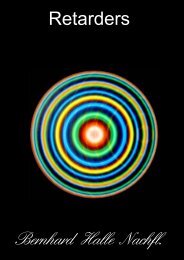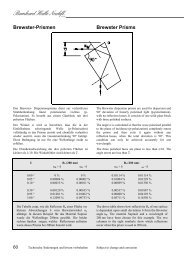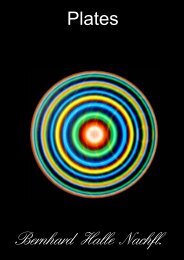Wollaston- und Rochon - Bernhard Halle
Wollaston- und Rochon - Bernhard Halle
Wollaston- und Rochon - Bernhard Halle
Sie wollen auch ein ePaper? Erhöhen Sie die Reichweite Ihrer Titel.
YUMPU macht aus Druck-PDFs automatisch weboptimierte ePaper, die Google liebt.
<strong>Bernhard</strong> <strong>Halle</strong> Nachfl.<br />
GmbH<br />
Sonderausführungen: Available on special order:<br />
Andere Wellenlängenbereiche oder einzelne Wellenlängen<br />
auf Anfrage<br />
Würfel aus Glas mit einem Brechungsindex, der dem des<br />
Kittes angepasst ist. Dabei werden Reflexionen zwischen<br />
Glas <strong>und</strong> Kitt vermieden, die zu störenden Interferenzen<br />
führen können. auf Anfrage<br />
Würfel in kittfreier Ausführung (mit optischem Kontakt)<br />
auf Anfrage<br />
Außerdem sind andere Geometrien - z.B. für zwei parallel<br />
austretende Lichtbündel oder mehrfache Strahlteilerkombinationen<br />
- möglich. auf Anfrage<br />
Auf Wunsch können λ/4- oder λ/2-Verzögerungsplatten zur<br />
Beeinflussung der Polarisation auf die Austrittsflächen<br />
gekittet werden. auf Anfrage<br />
Depolarisator nach Hanle<br />
(Scrambler)<br />
Der Depolarisator besteht aus zwei mit optischem Kontakt<br />
verb<strong>und</strong>enen Keilen, von denen mindestens einer<br />
doppelbrechend ist <strong>und</strong> die Polarisationszustände an<br />
verschiedenen Stellen unterschiedlich beeinflusst. Die<br />
Depolarisation entsteht aus der örtlichen Überlagerung<br />
verschieden gedrehter Polarisationen. Der zweite Keil<br />
kompensiert (bestmöglich) die prismatische Ablenkung.<br />
Die Divergenz der beiden austretenden, senkrecht<br />
zueinander polarisierten Bündel beträgt etwa<br />
4 Bogenminuten; die Ebenheit der Außenflächen ist λ/10,<br />
die Gesamtdicke etwa 6 - 10 mm.<br />
Der Depolarisator beeinflusst die Polarisation von<br />
Lichtquellen oder die Eigenpolarisation von Geräten in der<br />
Weise, dass der durchschnittliche Polarisationsgrad gegen<br />
Null geht. Dazu muss er zur jeweiligen Polarisation in die<br />
experimentell zu ermittelnde, günstigste Orientierung<br />
gebracht werden. (Als Startwert empfiehlt sich eine<br />
Anordnung der Aufspaltungsrichtung unter 45° zur<br />
Hauptpolarisationsrichtung des einfallenden Lichts). Die<br />
Wirkung des Depolarisators steigt mit dem Querschnitt des<br />
Strahlenbündels.<br />
Other wavelength ranges or single wavelengths<br />
on request<br />
Cubes made from glass with refractive index matching that<br />
of the cement. Hereby reflections between glass and cement<br />
(which might introduce disturbing interferences) are<br />
avoided on request<br />
Cubes assembled without cement (cube pairs in optical<br />
contact) on request<br />
Other geometries - i.e., for two parallel emerging beams or<br />
multiple beamsplitting combinations. on request<br />
According to your demands λ/4 or λ/2 retardation plates for<br />
influencing the polarization can be cemented on the exit<br />
face. on request<br />
Hanle Wedge Depolarizers<br />
(Scrambler)<br />
The depolarizer consists of two optically contacted wedges.<br />
At least one wedge is birefringent and affects the<br />
polarization state differently at different locations. The<br />
depolarization arises from the spatial superposition of<br />
rotated polarizations. The second wedge compensates for<br />
the prismatic deviation (as good as possible). The<br />
divergence of the two emerging beams polarized at right<br />
angles to each other is about 4 arc minutes. Flatness of the<br />
outer surfaces is λ/10. The total thickness is about 6 to<br />
10 mm.<br />
The depolarizer influences the polarization of light sources<br />
or of a device's own polarization so that the average degree<br />
of polarization is close to zero. Thus for each respective<br />
polarization the depolarizer must be adjusted to the most<br />
favourable orientation achievable by experimentation.<br />
(Usually it is a good starting value to orient the divergence<br />
<strong>und</strong>er 45° to the prevailing polarization direction of the<br />
incident light) The effectiveness of the depolarizer<br />
increases with the size of the beam cross-section.<br />
18 Technische Änderungen <strong>und</strong> Irrtum vorbehalten Subject to change and correction



